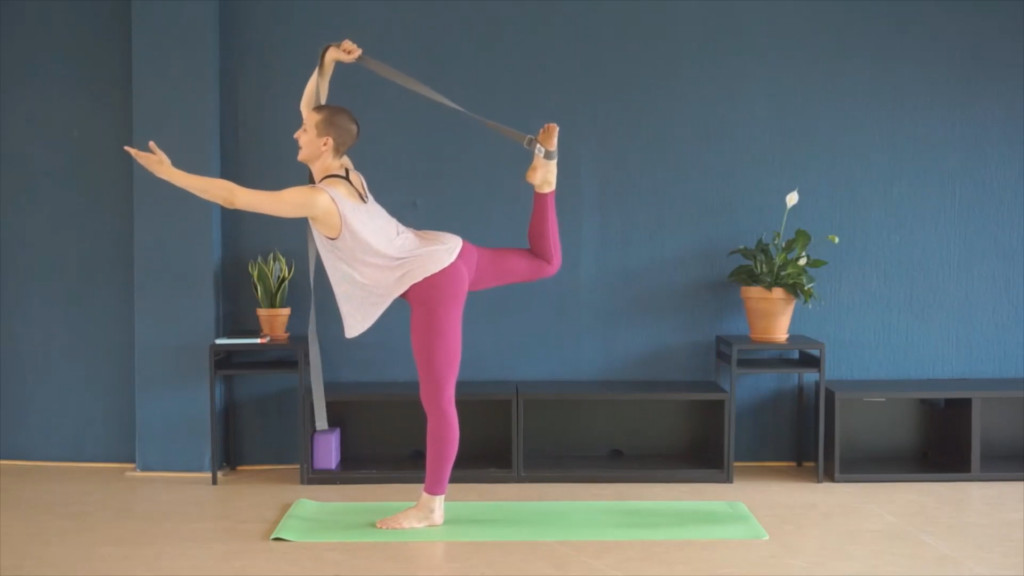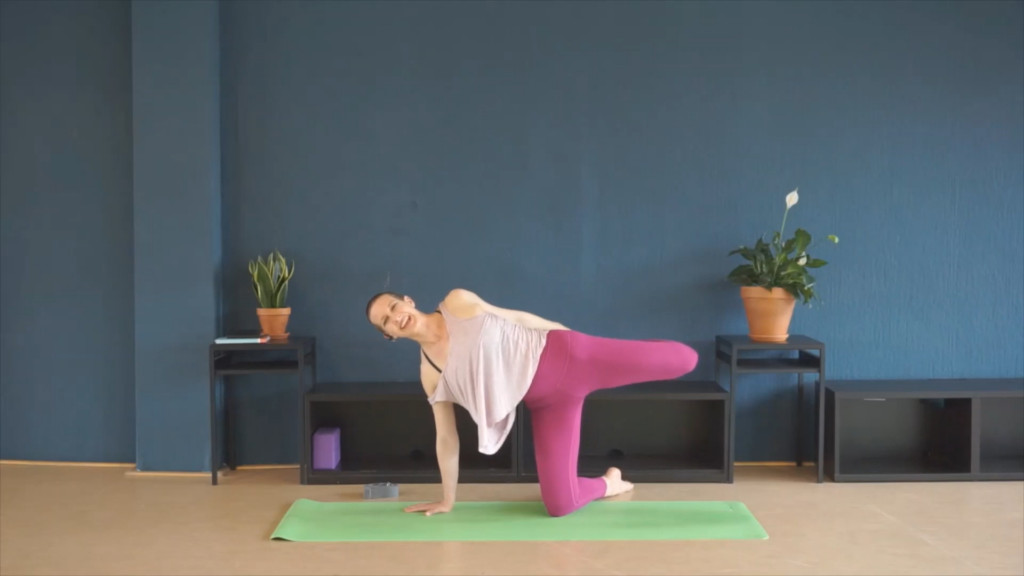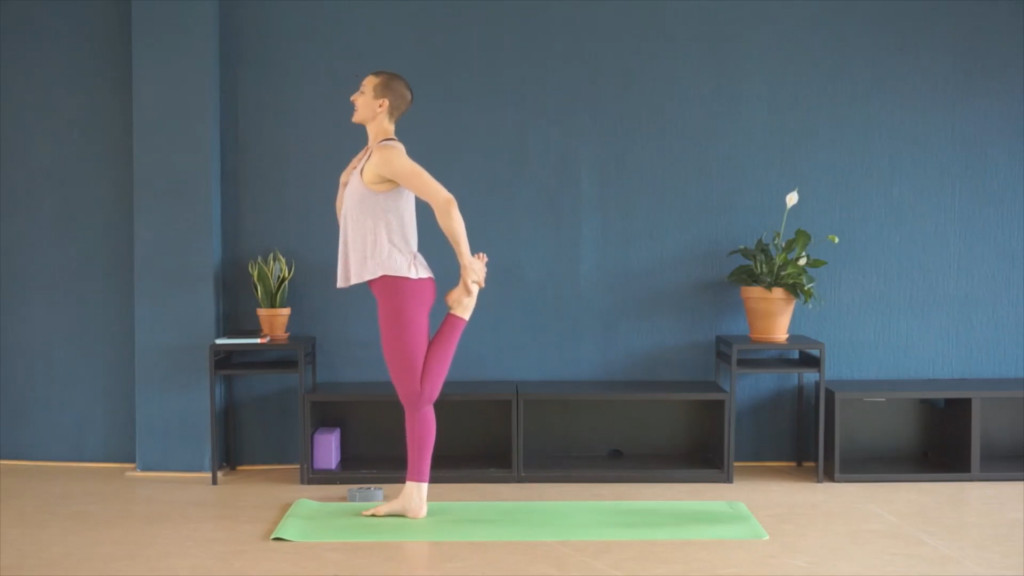Dancer’s Pose yoga, or Natarajasana, is more than just a beautiful asana; it’s a powerful posture that embodies balance, strength, and grace. Often simply called “Dancer Pose,” this iconic yoga pose challenges us to find our inner courage and compassion on the mat.
Shiva Nataraja, the Lord of Dance, inspires this pose. He is traditionally depicted dancing within a ring of fire, standing on a dwarf, with a cobra around his neck and dreadlocks swirling. This imagery is rich with symbolism, which we’ll explore further.
Dancer Pose is a standing posture that requires balance on one leg while the other leg is lifted behind, the foot grasped by the hand, and the body leans forward with the opposite arm extended. It can be both exhilarating and demanding. In this guide, we will delve into the steps, modifications, benefits, and the inspiring story behind Dancer Pose, helping you to safely and effectively incorporate it into your yoga practice.
Podcast 064: Daring Dancer Pose – story, strategy, & benefits of Natarajasana
Practicing Dancer Pose Safely: Precautions and Awareness
Safety is paramount in any yoga practice, and Dancer Pose is no exception. It’s crucial to approach this pose with awareness and caution. Remember, this information is for educational purposes and not a substitute for professional medical advice. Always consult with your doctor before starting any new exercise program, especially if you have pre-existing health conditions.
Yoga expert Mark Stephens, in his book Teaching Yoga, highlights the key physical considerations for Natarajasana: “Lower back, hamstrings and knee of the standing leg, shoulders if unstable or impinging.” (Teaching Yoga Location 4,091). These areas are vulnerable if the pose is performed incorrectly or without proper preparation.
Listen intently to your body. Move slowly and mindfully, respecting any signals of discomfort or pain. Never force yourself into the pose, and back off if you feel any strain.
Step-by-Step Guide: How to Get Into Dancer Pose (Natarajasana)
There are various approaches to entering Dancer Pose. Jessamyn Stanley, in Every Body Yoga: Let Go of Fear, Get On the Mat, Love Your Body, suggests both supported and unsupported variations. Using a yoga strap can be incredibly helpful, especially for beginners or those with tighter shoulders or hamstrings. A long belt or towel can serve as a substitute if you don’t have a yoga strap. Additionally, practicing near a wall or sturdy chair can provide balance support.
Here’s a breakdown of Stanley’s method for entering Dancer Pose:
- Begin in Mountain Pose (Tadasana): Stand tall with your feet hip-width apart, grounding down through all four corners of your feet.
- Shift Weight and Bend Knee: Place your right hand on your hip for stability and bend your left knee, bringing your left heel towards your left buttock.
- Grasp the Foot: Reach your left hand back and grasp the inside or outside of your left foot or ankle. If using a strap, loop it around your left foot and hold the strap in your left hand.
- Lift and Extend: Using your leg muscles, begin to lift your left thigh away from the floor, pressing your foot into your hand or the strap.
- Square Hips: Keep your hips squared forward, preventing them from opening to the side.
- Extend the Right Arm: Sweep your right arm forward and then up towards the ceiling, reaching through your fingertips.
- Deepen the Pose: Draw your standing thigh slightly back and gently soften your heart forward, opening your chest.
- Hold and Breathe: Maintain the pose for several breaths, focusing on your balance and breath.
- Release and Repeat: Slowly release the pose and repeat on the other side.
 Dancer Pose with strap for support
Dancer Pose with strap for support
Mark Stephens offers slightly different cues in Teaching Yoga:
- From Tadasana, flex your right knee and bring your right foot towards your right hip.
- Grasp the Right Foot with your right hand, rotating your right elbow inward and upward as you extend your right leg back and up from the hip.
- Lift Left Arm Overhead, bend your left elbow, and reach towards your right foot (this is a more advanced variation and can be omitted initially).
Stephens emphasizes key alignment points for both yoga teachers and practitioners:
- Pada Bandha (Foot Lock): Maintain a strong connection of the sole of the standing foot to the floor for stability in the foot and ankle.
- Standing Leg Engagement: Keep the standing leg straight and strong but avoid locking the knee.
- Pelvic Alignment: Keep the pelvis level to create a stable base for spinal extension.
- Chest Opening: Press the tailbone down and slightly forward to expand the chest and open the heart center.
- Shoulder Blades: Draw the lower tips of the shoulder blades forward and up to further open the chest.
- Gaze and Breath: If stable and comfortable, gently release the crown of the head towards the arch of the lifted foot and draw the elbows slightly together. Breathe deeply throughout the pose.
Dancer Pose Variations and Modifications
Exploring variations and modifications is key to making Dancer Pose accessible and beneficial for all levels. Here are a few variations to try:
Low Dancer Pose Variations: These variations offer a gentler approach to the classic pose, building strength and balance in a different plane.
- Low Side Dancer: Balancing on one arm and one knee, this variation provides a similar stretch to standing Dancer but with a lower center of gravity. You can still use a strap here to help with the foot hold.
 Low Side Dancer Pose variation
Low Side Dancer Pose variation
- Low Twisted Dancer: Similar to Low Side Dancer, but with a torso twist, adding a spinal twist element to the stretch and balance. A strap can also be used to assist with the foot and hand connection.
 Low Twisted Dancer Pose variation
Low Twisted Dancer Pose variation
- Hand-to-Heart Quad Stretch (Standing or Kneeling): This can be a preparatory pose for standing Dancer or a modification in itself. Standing or kneeling on one leg, reach back to hold the foot of the lifted leg, focusing on the quad stretch and gentle heart opening. A wall or chair can be used for balance.
 Hand to Heart Quad Stretch as a Dancer Pose modification
Hand to Heart Quad Stretch as a Dancer Pose modification
Other Helpful Modifications:
- Wall Support: Practice Dancer Pose facing a wall or with your side to the wall for added balance support.
- Chair Support: Use a chair for balance, placing one hand on the chair back while reaching for your foot with the other.
- Gaze (Drishti): Experiment with your gaze. Looking forward, slightly upward, or even towards your front hand can affect your balance.
- Hand Mudras: Explore different hand positions with your extended arm. Chin mudra (thumb and index finger touching) or Jnana mudra (similar to chin mudra) can be used, or simply extend the arm straight forward.
Remember, there are endless ways to adapt Dancer Pose to suit your body and practice. The key is to explore mindfully and find what works best for you.
The Story of Natarajasana: Shiva, the Cosmic Dancer
Understanding the mythology behind Natarajasana can deepen your appreciation for the pose. As explained in Myths of the Asanas: The Stories at the Heart of the Yoga Tradition by Alanna Kaivalya, Shiva Rea, and Manorama, Nataraja is a form of Shiva, the Master Dancer. Shiva’s dance is not merely for entertainment; it’s a cosmic dance of creation, preservation, and destruction, representing the eternal cycle of life.
Shiva, as Nataraja, dances to the beat of his drum, which symbolizes the rhythm of the universe. His dance destroys the old and makes way for new creation by Brahma. The ring of fire, or samsara, surrounding Shiva, represents the cycle of birth, life, death, and rebirth that we are all caught within.
The cobra around Shiva’s neck symbolizes avidya, the illusion or misunderstanding of our true divine nature. Shiva, having overcome avidya through enlightened knowledge, carries the flame of this knowledge in his palm, offering a remedy to this fundamental ignorance.
Benefits of Dancer Pose: Physical, Mental, and Spiritual
Dancer Pose offers a wealth of benefits on multiple levels:
Physical Benefits:
- Improves Balance and Stability: Being a standing balancing pose, Dancer Pose significantly enhances balance and strengthens the stabilizing muscles in the legs, ankles, and core.
- Strengthens Legs and Ankles: The standing leg works hard to maintain stability, building strength in the quadriceps, hamstrings, and calf muscles.
- Stretches Shoulders, Chest, and Hips: The backbending element of Dancer Pose opens the chest and shoulders, improving flexibility in these areas. It also stretches the hip flexors of the lifted leg.
- Improves Posture: By opening the chest and strengthening the back muscles, Dancer Pose can help improve overall posture.
Mental and Emotional Benefits:
- Builds Courage and Confidence: Facing the challenge of balance and backbending in Dancer Pose can help overcome fear and build self-confidence.
- Cultivates Focus and Concentration: Maintaining balance in the pose requires focus and concentration, which can translate to improved focus in daily life.
- Releases Emotional Blockages: Heart-opening poses like Dancer Pose are believed to release stored emotions, particularly fear, held in the heart chakra.
Spiritual Benefits:
- Embracing Change: Shiva’s dance symbolizes the constant change in the universe. Practicing Dancer Pose can help us become more comfortable with change and impermanence.
- Self-Awareness and Self-Study (Svadhyaya): The challenges of Dancer Pose encourage self-reflection and self-awareness. As Dianne Bondy and Kat Heagberg emphasize in Yoga Where You Are, compassionate self-study is about meeting yourself “without judgement, just where you are and just how you are.” (p.212).
- Freedom and Liberation: Just as Shiva’s dance is born from liberation, Dancer Pose can be a practice of finding freedom – freedom of movement, freedom from fear, and freedom to embrace our true selves.
Reflection and Contemplation on Dancer Pose
To deepen your experience with Dancer Pose, consider these questions for reflection:
- What are your personal challenges when practicing Dancer Pose?
- Which modifications or variations make the pose more accessible for you?
- What other yoga poses or movements do you find particularly challenging?
- What emotions arise for you when faced with these challenges?
- How can modifications help you experience the benefits of challenging poses or activities?
- How can a yoga teacher or trusted guide support your practice and growth?
Dancer Pose is a journey of self-discovery, both on and off the mat. By embracing the challenges and exploring the depths of this asana, we can tap into its transformative power and embody the grace and strength of the cosmic dancer within.
Blythe Stephens, MFA & Bliss Catalyst
she/her or they/them
A Blythe Coach: Dance Education & Coaching move through life with balance, grace, & power
DISCLAIMER: A Blythe Coach recommends that you consult your physician regarding the applicability of any recommendations and follow all safety instructions before beginning any exercise program. When participating in any exercise or exercise program, there is the possibility of physical injury. If you engage in this exercise or exercise program, you agree that you do so at your own risk, are voluntarily participating in these activities, assume all risk of injury to yourself.


